Clustered Assessment: CHCECE001 & CHCECE026, Sensitive Practice
VerifiedAdded on 2023/06/10
|44
|10683
|50
Homework Assignment
AI Summary
This document presents a completed clustered assessment for the units CHCECE001 (Develop cultural competence) and CHCECE026 (Work in partnership with families to provide appropriate education and care for children), part of a TAFE NSW program. The assessment evaluates the student's ability to identify and develop cultural competence within an early childhood education and care service. It includes analyzing the cultural diversity of the service, critically reflecting on educator-child and child-child interactions, and evaluating curriculum activities for cultural sensitivity. The assessment also requires the student to identify opportunities to enhance culturally competent interactions and curriculum, demonstrating an understanding of inclusive practices. The assessment is broken down into different parts, including identifying cultural identities, observing interactions, and critically analyzing curriculum and activities. The assessment also includes workplace-based observations and written components, requiring the student to demonstrate their skills and knowledge in a regulated education and care service, and to reflect on their own cultural biases. The goal is to ensure that the student can support the participation of all children and families in children's services and work effectively in partnership with families.
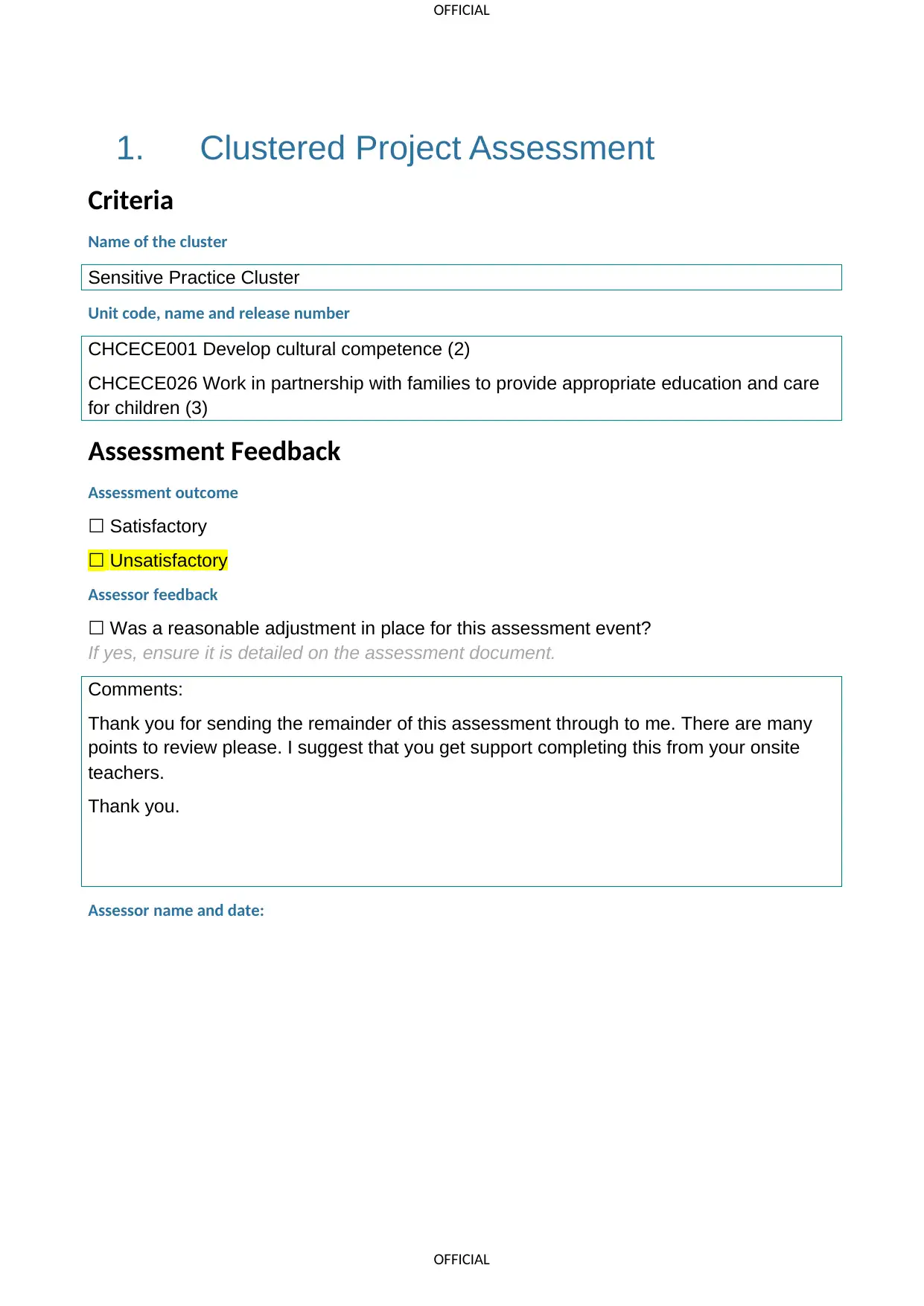
OFFICIAL
OFFICIAL
1. Clustered Project Assessment
Criteria
Name of the cluster
Sensitive Practice Cluster
Unit code, name and release number
CHCECE001 Develop cultural competence (2)
CHCECE026 Work in partnership with families to provide appropriate education and care
for children (3)
Assessment Feedback
Assessment outcome
☐ Satisfactory
☐ Unsatisfactory
Assessor feedback
☐ Was a reasonable adjustment in place for this assessment event?
If yes, ensure it is detailed on the assessment document.
Comments:
Thank you for sending the remainder of this assessment through to me. There are many
points to review please. I suggest that you get support completing this from your onsite
teachers.
Thank you.
Assessor name and date:
OFFICIAL
1. Clustered Project Assessment
Criteria
Name of the cluster
Sensitive Practice Cluster
Unit code, name and release number
CHCECE001 Develop cultural competence (2)
CHCECE026 Work in partnership with families to provide appropriate education and care
for children (3)
Assessment Feedback
Assessment outcome
☐ Satisfactory
☐ Unsatisfactory
Assessor feedback
☐ Was a reasonable adjustment in place for this assessment event?
If yes, ensure it is detailed on the assessment document.
Comments:
Thank you for sending the remainder of this assessment through to me. There are many
points to review please. I suggest that you get support completing this from your onsite
teachers.
Thank you.
Assessor name and date:
Paraphrase This Document
Need a fresh take? Get an instant paraphrase of this document with our AI Paraphraser
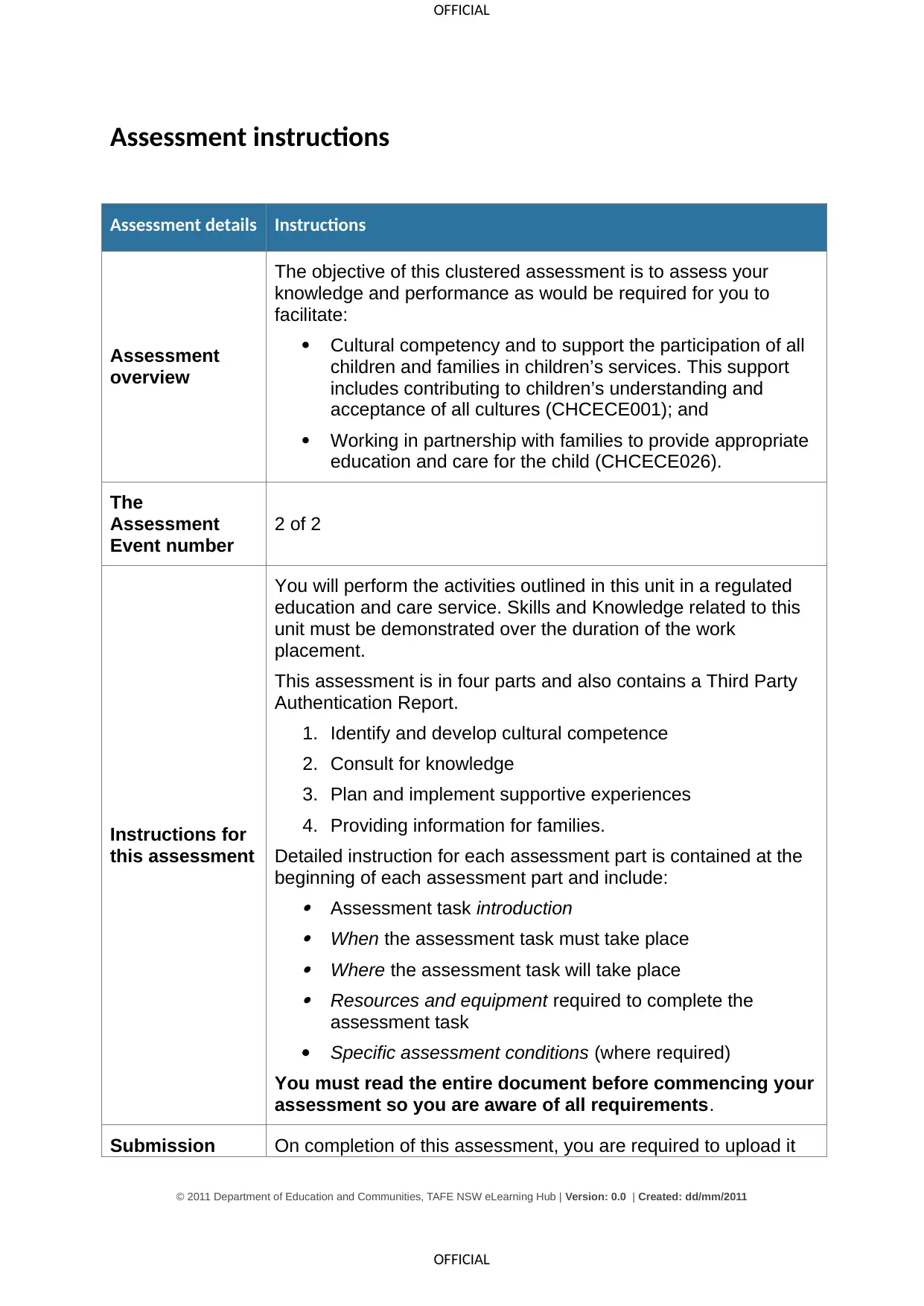
OFFICIAL
OFFICIAL
Assessment instructions
Table 1 Assessment instructions
Assessment details Instructions
Assessment
overview
The objective of this clustered assessment is to assess your
knowledge and performance as would be required for you to
facilitate:
Cultural competency and to support the participation of all
children and families in children’s services. This support
includes contributing to children’s understanding and
acceptance of all cultures (CHCECE001); and
Working in partnership with families to provide appropriate
education and care for the child (CHCECE026).
The
Assessment
Event number
2 of 2
Instructions for
this assessment
You will perform the activities outlined in this unit in a regulated
education and care service. Skills and Knowledge related to this
unit must be demonstrated over the duration of the work
placement.
This assessment is in four parts and also contains a Third Party
Authentication Report.
1. Identify and develop cultural competence
2. Consult for knowledge
3. Plan and implement supportive experiences
4. Providing information for families.
Detailed instruction for each assessment part is contained at the
beginning of each assessment part and include:
Assessment task introduction
When the assessment task must take place
Where the assessment task will take place
Resources and equipment required to complete the
assessment task
Specific assessment conditions (where required)
You must read the entire document before commencing your
assessment so you are aware of all requirements.
Submission On completion of this assessment, you are required to upload it
© 2011 Department of Education and Communities, TAFE NSW eLearning Hub | Version: 0.0 | Created: dd/mm/2011
OFFICIAL
Assessment instructions
Table 1 Assessment instructions
Assessment details Instructions
Assessment
overview
The objective of this clustered assessment is to assess your
knowledge and performance as would be required for you to
facilitate:
Cultural competency and to support the participation of all
children and families in children’s services. This support
includes contributing to children’s understanding and
acceptance of all cultures (CHCECE001); and
Working in partnership with families to provide appropriate
education and care for the child (CHCECE026).
The
Assessment
Event number
2 of 2
Instructions for
this assessment
You will perform the activities outlined in this unit in a regulated
education and care service. Skills and Knowledge related to this
unit must be demonstrated over the duration of the work
placement.
This assessment is in four parts and also contains a Third Party
Authentication Report.
1. Identify and develop cultural competence
2. Consult for knowledge
3. Plan and implement supportive experiences
4. Providing information for families.
Detailed instruction for each assessment part is contained at the
beginning of each assessment part and include:
Assessment task introduction
When the assessment task must take place
Where the assessment task will take place
Resources and equipment required to complete the
assessment task
Specific assessment conditions (where required)
You must read the entire document before commencing your
assessment so you are aware of all requirements.
Submission On completion of this assessment, you are required to upload it
© 2011 Department of Education and Communities, TAFE NSW eLearning Hub | Version: 0.0 | Created: dd/mm/2011
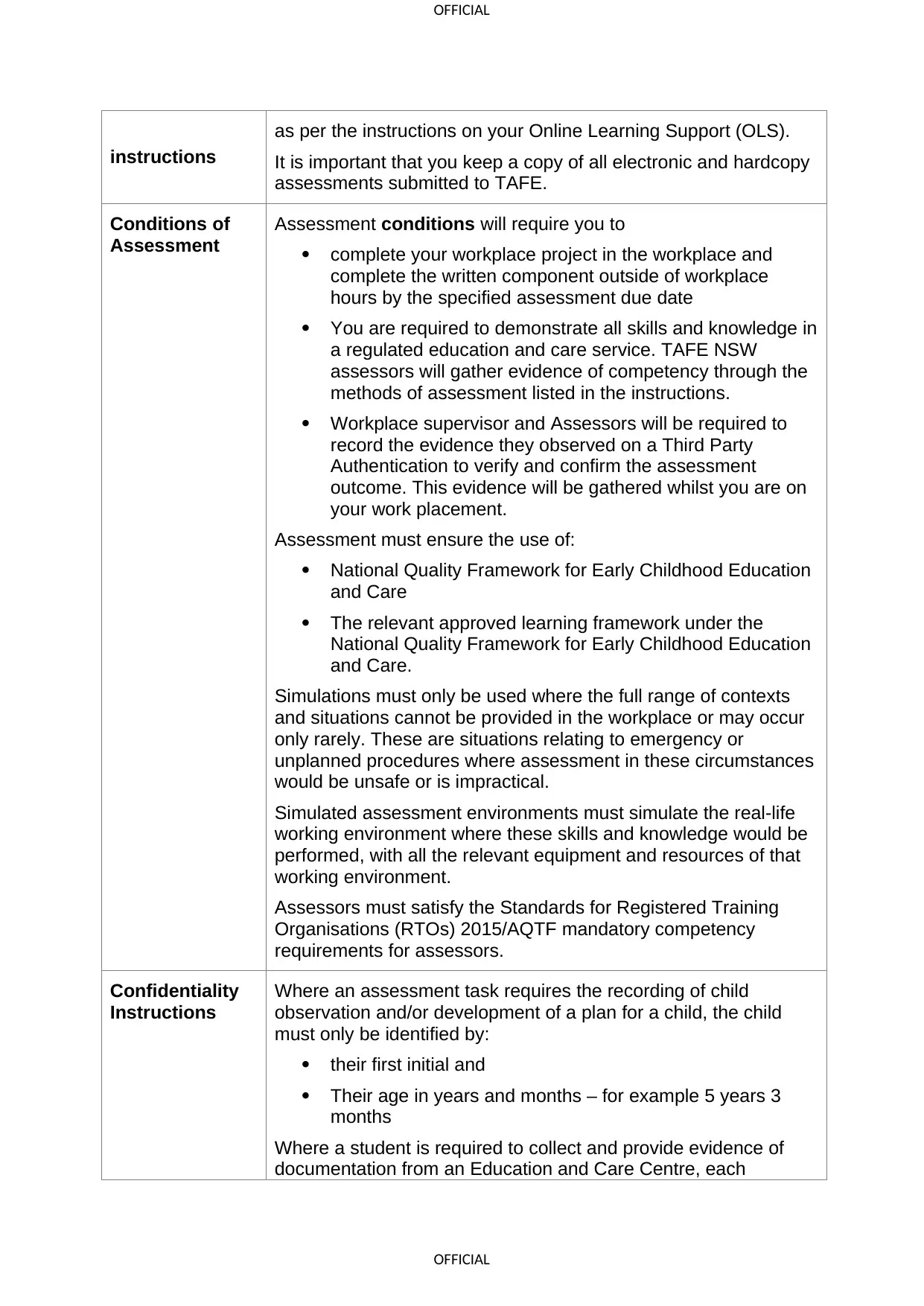
OFFICIAL
OFFICIAL
instructions
as per the instructions on your Online Learning Support (OLS).
It is important that you keep a copy of all electronic and hardcopy
assessments submitted to TAFE.
Conditions of
Assessment
Assessment conditions will require you to
complete your workplace project in the workplace and
complete the written component outside of workplace
hours by the specified assessment due date
You are required to demonstrate all skills and knowledge in
a regulated education and care service. TAFE NSW
assessors will gather evidence of competency through the
methods of assessment listed in the instructions.
Workplace supervisor and Assessors will be required to
record the evidence they observed on a Third Party
Authentication to verify and confirm the assessment
outcome. This evidence will be gathered whilst you are on
your work placement.
Assessment must ensure the use of:
National Quality Framework for Early Childhood Education
and Care
The relevant approved learning framework under the
National Quality Framework for Early Childhood Education
and Care.
Simulations must only be used where the full range of contexts
and situations cannot be provided in the workplace or may occur
only rarely. These are situations relating to emergency or
unplanned procedures where assessment in these circumstances
would be unsafe or is impractical.
Simulated assessment environments must simulate the real-life
working environment where these skills and knowledge would be
performed, with all the relevant equipment and resources of that
working environment.
Assessors must satisfy the Standards for Registered Training
Organisations (RTOs) 2015/AQTF mandatory competency
requirements for assessors.
Confidentiality
Instructions
Where an assessment task requires the recording of child
observation and/or development of a plan for a child, the child
must only be identified by:
their first initial and
Their age in years and months – for example 5 years 3
months
Where a student is required to collect and provide evidence of
documentation from an Education and Care Centre, each
OFFICIAL
instructions
as per the instructions on your Online Learning Support (OLS).
It is important that you keep a copy of all electronic and hardcopy
assessments submitted to TAFE.
Conditions of
Assessment
Assessment conditions will require you to
complete your workplace project in the workplace and
complete the written component outside of workplace
hours by the specified assessment due date
You are required to demonstrate all skills and knowledge in
a regulated education and care service. TAFE NSW
assessors will gather evidence of competency through the
methods of assessment listed in the instructions.
Workplace supervisor and Assessors will be required to
record the evidence they observed on a Third Party
Authentication to verify and confirm the assessment
outcome. This evidence will be gathered whilst you are on
your work placement.
Assessment must ensure the use of:
National Quality Framework for Early Childhood Education
and Care
The relevant approved learning framework under the
National Quality Framework for Early Childhood Education
and Care.
Simulations must only be used where the full range of contexts
and situations cannot be provided in the workplace or may occur
only rarely. These are situations relating to emergency or
unplanned procedures where assessment in these circumstances
would be unsafe or is impractical.
Simulated assessment environments must simulate the real-life
working environment where these skills and knowledge would be
performed, with all the relevant equipment and resources of that
working environment.
Assessors must satisfy the Standards for Registered Training
Organisations (RTOs) 2015/AQTF mandatory competency
requirements for assessors.
Confidentiality
Instructions
Where an assessment task requires the recording of child
observation and/or development of a plan for a child, the child
must only be identified by:
their first initial and
Their age in years and months – for example 5 years 3
months
Where a student is required to collect and provide evidence of
documentation from an Education and Care Centre, each
⊘ This is a preview!⊘
Do you want full access?
Subscribe today to unlock all pages.

Trusted by 1+ million students worldwide
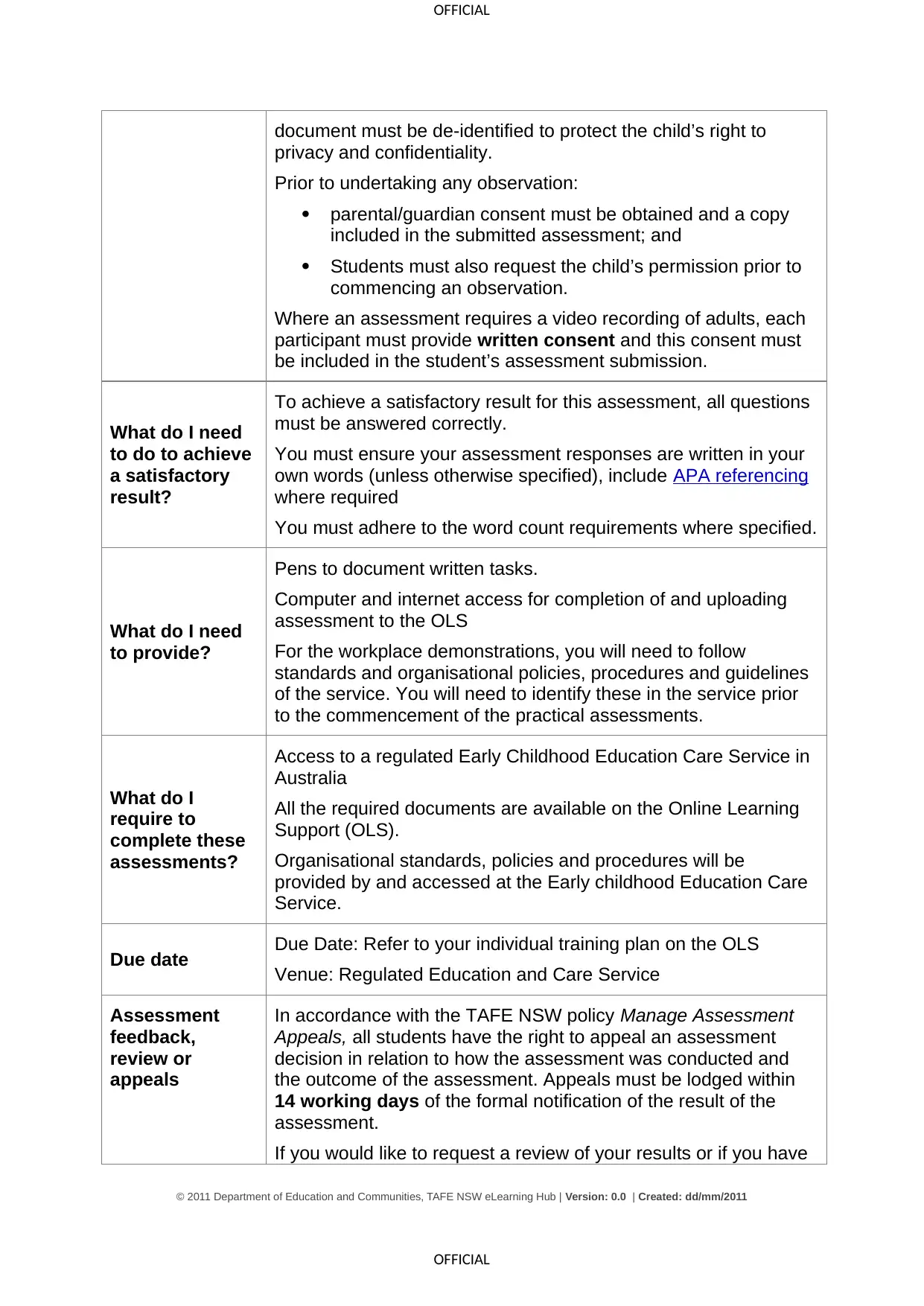
OFFICIAL
OFFICIAL
document must be de-identified to protect the child’s right to
privacy and confidentiality.
Prior to undertaking any observation:
parental/guardian consent must be obtained and a copy
included in the submitted assessment; and
Students must also request the child’s permission prior to
commencing an observation.
Where an assessment requires a video recording of adults, each
participant must provide written consent and this consent must
be included in the student’s assessment submission.
What do I need
to do to achieve
a satisfactory
result?
To achieve a satisfactory result for this assessment, all questions
must be answered correctly.
You must ensure your assessment responses are written in your
own words (unless otherwise specified), include APA referencing
where required
You must adhere to the word count requirements where specified.
What do I need
to provide?
Pens to document written tasks.
Computer and internet access for completion of and uploading
assessment to the OLS
For the workplace demonstrations, you will need to follow
standards and organisational policies, procedures and guidelines
of the service. You will need to identify these in the service prior
to the commencement of the practical assessments.
What do I
require to
complete these
assessments?
Access to a regulated Early Childhood Education Care Service in
Australia
All the required documents are available on the Online Learning
Support (OLS).
Organisational standards, policies and procedures will be
provided by and accessed at the Early childhood Education Care
Service.
Due date Due Date: Refer to your individual training plan on the OLS
Venue: Regulated Education and Care Service
Assessment
feedback,
review or
appeals
In accordance with the TAFE NSW policy Manage Assessment
Appeals, all students have the right to appeal an assessment
decision in relation to how the assessment was conducted and
the outcome of the assessment. Appeals must be lodged within
14 working days of the formal notification of the result of the
assessment.
If you would like to request a review of your results or if you have
© 2011 Department of Education and Communities, TAFE NSW eLearning Hub | Version: 0.0 | Created: dd/mm/2011
OFFICIAL
document must be de-identified to protect the child’s right to
privacy and confidentiality.
Prior to undertaking any observation:
parental/guardian consent must be obtained and a copy
included in the submitted assessment; and
Students must also request the child’s permission prior to
commencing an observation.
Where an assessment requires a video recording of adults, each
participant must provide written consent and this consent must
be included in the student’s assessment submission.
What do I need
to do to achieve
a satisfactory
result?
To achieve a satisfactory result for this assessment, all questions
must be answered correctly.
You must ensure your assessment responses are written in your
own words (unless otherwise specified), include APA referencing
where required
You must adhere to the word count requirements where specified.
What do I need
to provide?
Pens to document written tasks.
Computer and internet access for completion of and uploading
assessment to the OLS
For the workplace demonstrations, you will need to follow
standards and organisational policies, procedures and guidelines
of the service. You will need to identify these in the service prior
to the commencement of the practical assessments.
What do I
require to
complete these
assessments?
Access to a regulated Early Childhood Education Care Service in
Australia
All the required documents are available on the Online Learning
Support (OLS).
Organisational standards, policies and procedures will be
provided by and accessed at the Early childhood Education Care
Service.
Due date Due Date: Refer to your individual training plan on the OLS
Venue: Regulated Education and Care Service
Assessment
feedback,
review or
appeals
In accordance with the TAFE NSW policy Manage Assessment
Appeals, all students have the right to appeal an assessment
decision in relation to how the assessment was conducted and
the outcome of the assessment. Appeals must be lodged within
14 working days of the formal notification of the result of the
assessment.
If you would like to request a review of your results or if you have
© 2011 Department of Education and Communities, TAFE NSW eLearning Hub | Version: 0.0 | Created: dd/mm/2011
Paraphrase This Document
Need a fresh take? Get an instant paraphrase of this document with our AI Paraphraser
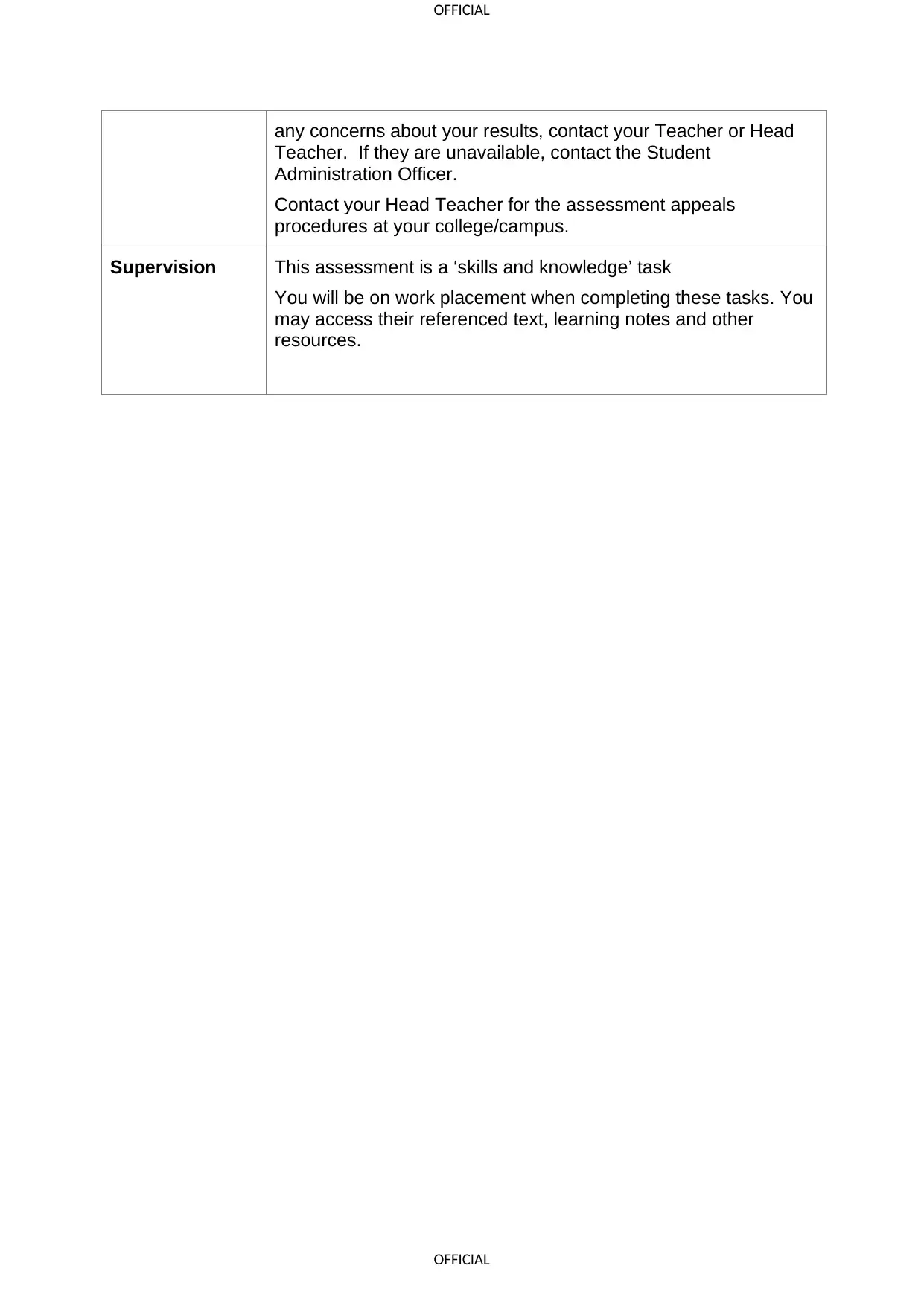
OFFICIAL
OFFICIAL
any concerns about your results, contact your Teacher or Head
Teacher. If they are unavailable, contact the Student
Administration Officer.
Contact your Head Teacher for the assessment appeals
procedures at your college/campus.
Supervision This assessment is a ‘skills and knowledge’ task
You will be on work placement when completing these tasks. You
may access their referenced text, learning notes and other
resources.
OFFICIAL
any concerns about your results, contact your Teacher or Head
Teacher. If they are unavailable, contact the Student
Administration Officer.
Contact your Head Teacher for the assessment appeals
procedures at your college/campus.
Supervision This assessment is a ‘skills and knowledge’ task
You will be on work placement when completing these tasks. You
may access their referenced text, learning notes and other
resources.
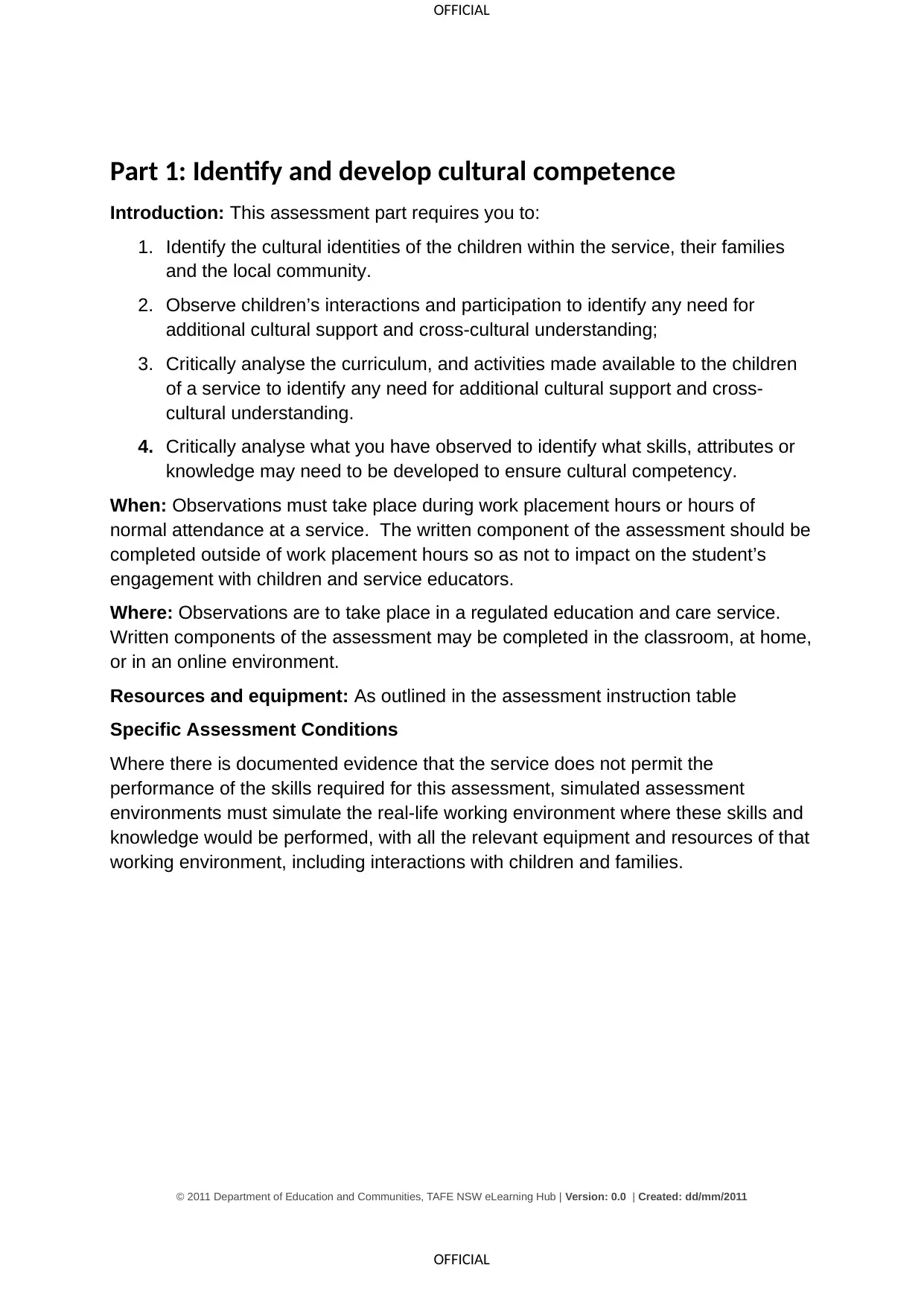
OFFICIAL
OFFICIAL
Part 1: Identify and develop cultural competence
Introduction: This assessment part requires you to:
1. Identify the cultural identities of the children within the service, their families
and the local community.
2. Observe children’s interactions and participation to identify any need for
additional cultural support and cross-cultural understanding;
3. Critically analyse the curriculum, and activities made available to the children
of a service to identify any need for additional cultural support and cross-
cultural understanding.
4. Critically analyse what you have observed to identify what skills, attributes or
knowledge may need to be developed to ensure cultural competency.
When: Observations must take place during work placement hours or hours of
normal attendance at a service. The written component of the assessment should be
completed outside of work placement hours so as not to impact on the student’s
engagement with children and service educators.
Where: Observations are to take place in a regulated education and care service.
Written components of the assessment may be completed in the classroom, at home,
or in an online environment.
Resources and equipment: As outlined in the assessment instruction table
Specific Assessment Conditions
Where there is documented evidence that the service does not permit the
performance of the skills required for this assessment, simulated assessment
environments must simulate the real-life working environment where these skills and
knowledge would be performed, with all the relevant equipment and resources of that
working environment, including interactions with children and families.
© 2011 Department of Education and Communities, TAFE NSW eLearning Hub | Version: 0.0 | Created: dd/mm/2011
OFFICIAL
Part 1: Identify and develop cultural competence
Introduction: This assessment part requires you to:
1. Identify the cultural identities of the children within the service, their families
and the local community.
2. Observe children’s interactions and participation to identify any need for
additional cultural support and cross-cultural understanding;
3. Critically analyse the curriculum, and activities made available to the children
of a service to identify any need for additional cultural support and cross-
cultural understanding.
4. Critically analyse what you have observed to identify what skills, attributes or
knowledge may need to be developed to ensure cultural competency.
When: Observations must take place during work placement hours or hours of
normal attendance at a service. The written component of the assessment should be
completed outside of work placement hours so as not to impact on the student’s
engagement with children and service educators.
Where: Observations are to take place in a regulated education and care service.
Written components of the assessment may be completed in the classroom, at home,
or in an online environment.
Resources and equipment: As outlined in the assessment instruction table
Specific Assessment Conditions
Where there is documented evidence that the service does not permit the
performance of the skills required for this assessment, simulated assessment
environments must simulate the real-life working environment where these skills and
knowledge would be performed, with all the relevant equipment and resources of that
working environment, including interactions with children and families.
© 2011 Department of Education and Communities, TAFE NSW eLearning Hub | Version: 0.0 | Created: dd/mm/2011
⊘ This is a preview!⊘
Do you want full access?
Subscribe today to unlock all pages.

Trusted by 1+ million students worldwide
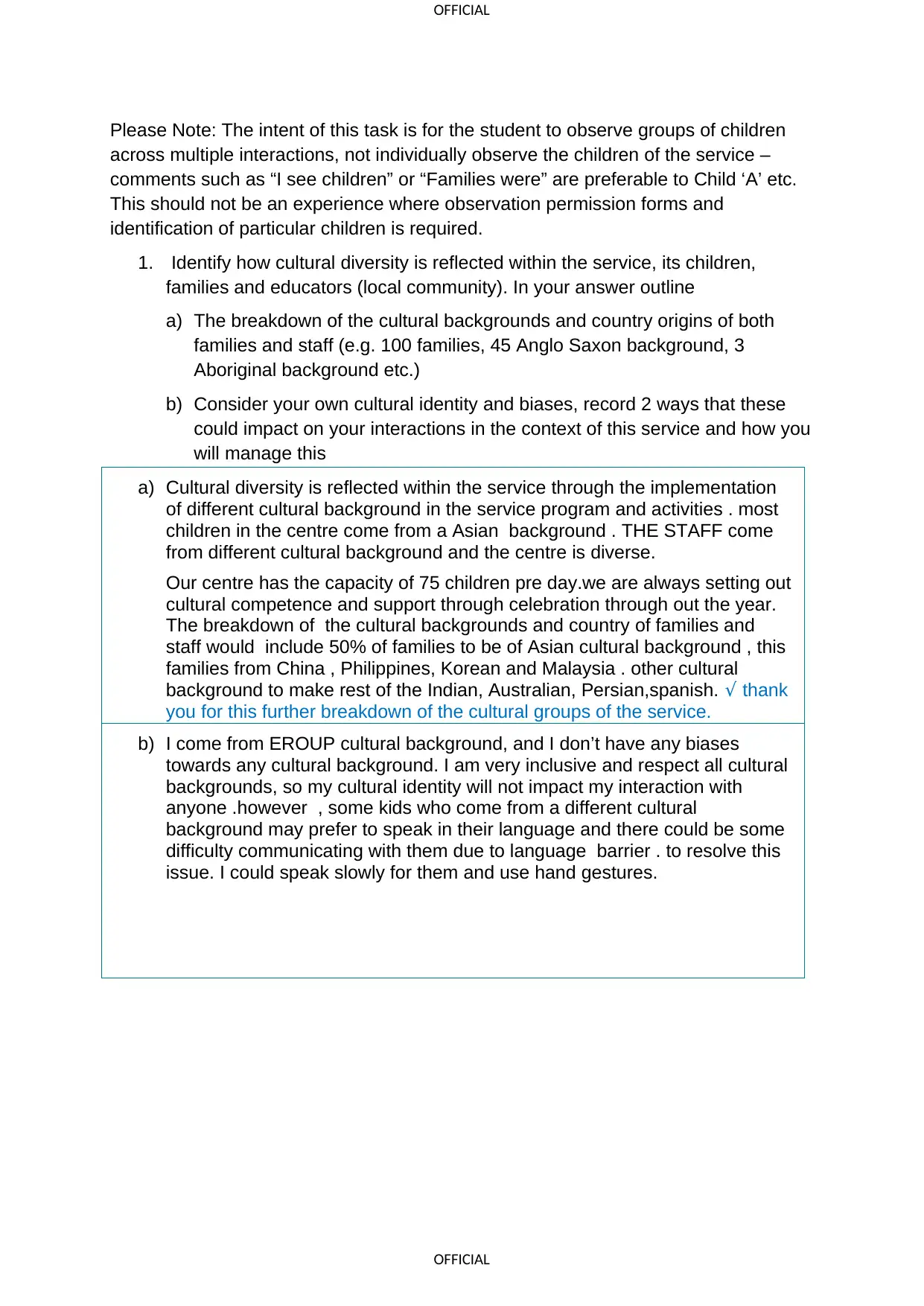
OFFICIAL
OFFICIAL
Please Note: The intent of this task is for the student to observe groups of children
across multiple interactions, not individually observe the children of the service –
comments such as “I see children” or “Families were” are preferable to Child ‘A’ etc.
This should not be an experience where observation permission forms and
identification of particular children is required.
1. Identify how cultural diversity is reflected within the service, its children,
families and educators (local community). In your answer outline
a) The breakdown of the cultural backgrounds and country origins of both
families and staff (e.g. 100 families, 45 Anglo Saxon background, 3
Aboriginal background etc.)
b) Consider your own cultural identity and biases, record 2 ways that these
could impact on your interactions in the context of this service and how you
will manage this
a) Cultural diversity is reflected within the service through the implementation
of different cultural background in the service program and activities . most
children in the centre come from a Asian background . THE STAFF come
from different cultural background and the centre is diverse.
Our centre has the capacity of 75 children pre day.we are always setting out
cultural competence and support through celebration through out the year.
The breakdown of the cultural backgrounds and country of families and
staff would include 50% of families to be of Asian cultural background , this
families from China , Philippines, Korean and Malaysia . other cultural
background to make rest of the Indian, Australian, Persian,spanish. √ thank
you for this further breakdown of the cultural groups of the service.
b) I come from EROUP cultural background, and I don’t have any biases
towards any cultural background. I am very inclusive and respect all cultural
backgrounds, so my cultural identity will not impact my interaction with
anyone .however , some kids who come from a different cultural
background may prefer to speak in their language and there could be some
difficulty communicating with them due to language barrier . to resolve this
issue. I could speak slowly for them and use hand gestures.
OFFICIAL
Please Note: The intent of this task is for the student to observe groups of children
across multiple interactions, not individually observe the children of the service –
comments such as “I see children” or “Families were” are preferable to Child ‘A’ etc.
This should not be an experience where observation permission forms and
identification of particular children is required.
1. Identify how cultural diversity is reflected within the service, its children,
families and educators (local community). In your answer outline
a) The breakdown of the cultural backgrounds and country origins of both
families and staff (e.g. 100 families, 45 Anglo Saxon background, 3
Aboriginal background etc.)
b) Consider your own cultural identity and biases, record 2 ways that these
could impact on your interactions in the context of this service and how you
will manage this
a) Cultural diversity is reflected within the service through the implementation
of different cultural background in the service program and activities . most
children in the centre come from a Asian background . THE STAFF come
from different cultural background and the centre is diverse.
Our centre has the capacity of 75 children pre day.we are always setting out
cultural competence and support through celebration through out the year.
The breakdown of the cultural backgrounds and country of families and
staff would include 50% of families to be of Asian cultural background , this
families from China , Philippines, Korean and Malaysia . other cultural
background to make rest of the Indian, Australian, Persian,spanish. √ thank
you for this further breakdown of the cultural groups of the service.
b) I come from EROUP cultural background, and I don’t have any biases
towards any cultural background. I am very inclusive and respect all cultural
backgrounds, so my cultural identity will not impact my interaction with
anyone .however , some kids who come from a different cultural
background may prefer to speak in their language and there could be some
difficulty communicating with them due to language barrier . to resolve this
issue. I could speak slowly for them and use hand gestures.
Paraphrase This Document
Need a fresh take? Get an instant paraphrase of this document with our AI Paraphraser
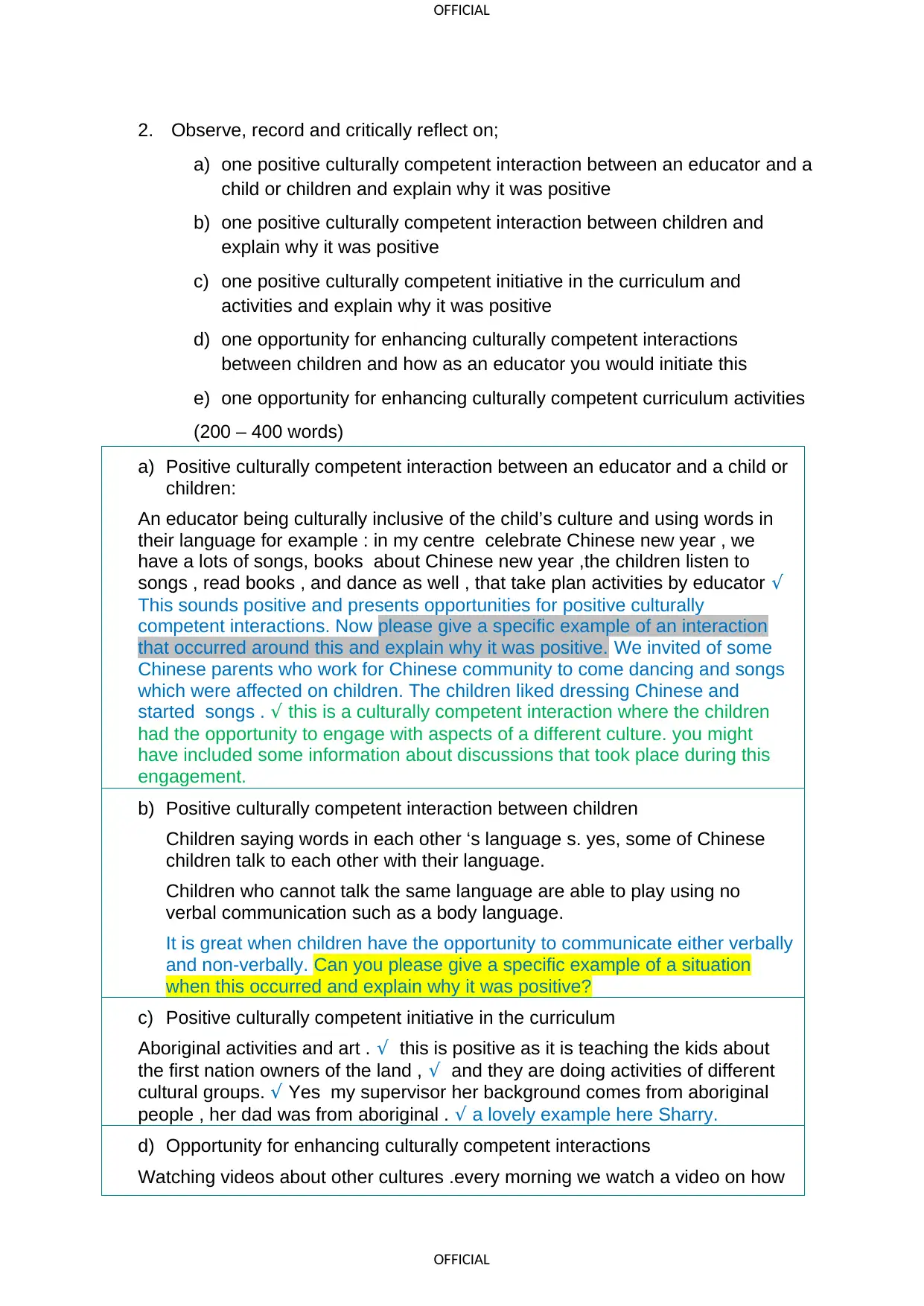
OFFICIAL
OFFICIAL
2. Observe, record and critically reflect on;
a) one positive culturally competent interaction between an educator and a
child or children and explain why it was positive
b) one positive culturally competent interaction between children and
explain why it was positive
c) one positive culturally competent initiative in the curriculum and
activities and explain why it was positive
d) one opportunity for enhancing culturally competent interactions
between children and how as an educator you would initiate this
e) one opportunity for enhancing culturally competent curriculum activities
(200 – 400 words)
a) Positive culturally competent interaction between an educator and a child or
children:
An educator being culturally inclusive of the child’s culture and using words in
their language for example : in my centre celebrate Chinese new year , we
have a lots of songs, books about Chinese new year ,the children listen to
songs , read books , and dance as well , that take plan activities by educator √
This sounds positive and presents opportunities for positive culturally
competent interactions. Now please give a specific example of an interaction
that occurred around this and explain why it was positive. We invited of some
Chinese parents who work for Chinese community to come dancing and songs
which were affected on children. The children liked dressing Chinese and
started songs . √ this is a culturally competent interaction where the children
had the opportunity to engage with aspects of a different culture. you might
have included some information about discussions that took place during this
engagement.
b) Positive culturally competent interaction between children
Children saying words in each other ‘s language s. yes, some of Chinese
children talk to each other with their language.
Children who cannot talk the same language are able to play using no
verbal communication such as a body language.
It is great when children have the opportunity to communicate either verbally
and non-verbally. Can you please give a specific example of a situation
when this occurred and explain why it was positive?
c) Positive culturally competent initiative in the curriculum
Aboriginal activities and art . √ this is positive as it is teaching the kids about
the first nation owners of the land , √ and they are doing activities of different
cultural groups. √ Yes my supervisor her background comes from aboriginal
people , her dad was from aboriginal . √ a lovely example here Sharry.
d) Opportunity for enhancing culturally competent interactions
Watching videos about other cultures .every morning we watch a video on how
OFFICIAL
2. Observe, record and critically reflect on;
a) one positive culturally competent interaction between an educator and a
child or children and explain why it was positive
b) one positive culturally competent interaction between children and
explain why it was positive
c) one positive culturally competent initiative in the curriculum and
activities and explain why it was positive
d) one opportunity for enhancing culturally competent interactions
between children and how as an educator you would initiate this
e) one opportunity for enhancing culturally competent curriculum activities
(200 – 400 words)
a) Positive culturally competent interaction between an educator and a child or
children:
An educator being culturally inclusive of the child’s culture and using words in
their language for example : in my centre celebrate Chinese new year , we
have a lots of songs, books about Chinese new year ,the children listen to
songs , read books , and dance as well , that take plan activities by educator √
This sounds positive and presents opportunities for positive culturally
competent interactions. Now please give a specific example of an interaction
that occurred around this and explain why it was positive. We invited of some
Chinese parents who work for Chinese community to come dancing and songs
which were affected on children. The children liked dressing Chinese and
started songs . √ this is a culturally competent interaction where the children
had the opportunity to engage with aspects of a different culture. you might
have included some information about discussions that took place during this
engagement.
b) Positive culturally competent interaction between children
Children saying words in each other ‘s language s. yes, some of Chinese
children talk to each other with their language.
Children who cannot talk the same language are able to play using no
verbal communication such as a body language.
It is great when children have the opportunity to communicate either verbally
and non-verbally. Can you please give a specific example of a situation
when this occurred and explain why it was positive?
c) Positive culturally competent initiative in the curriculum
Aboriginal activities and art . √ this is positive as it is teaching the kids about
the first nation owners of the land , √ and they are doing activities of different
cultural groups. √ Yes my supervisor her background comes from aboriginal
people , her dad was from aboriginal . √ a lovely example here Sharry.
d) Opportunity for enhancing culturally competent interactions
Watching videos about other cultures .every morning we watch a video on how
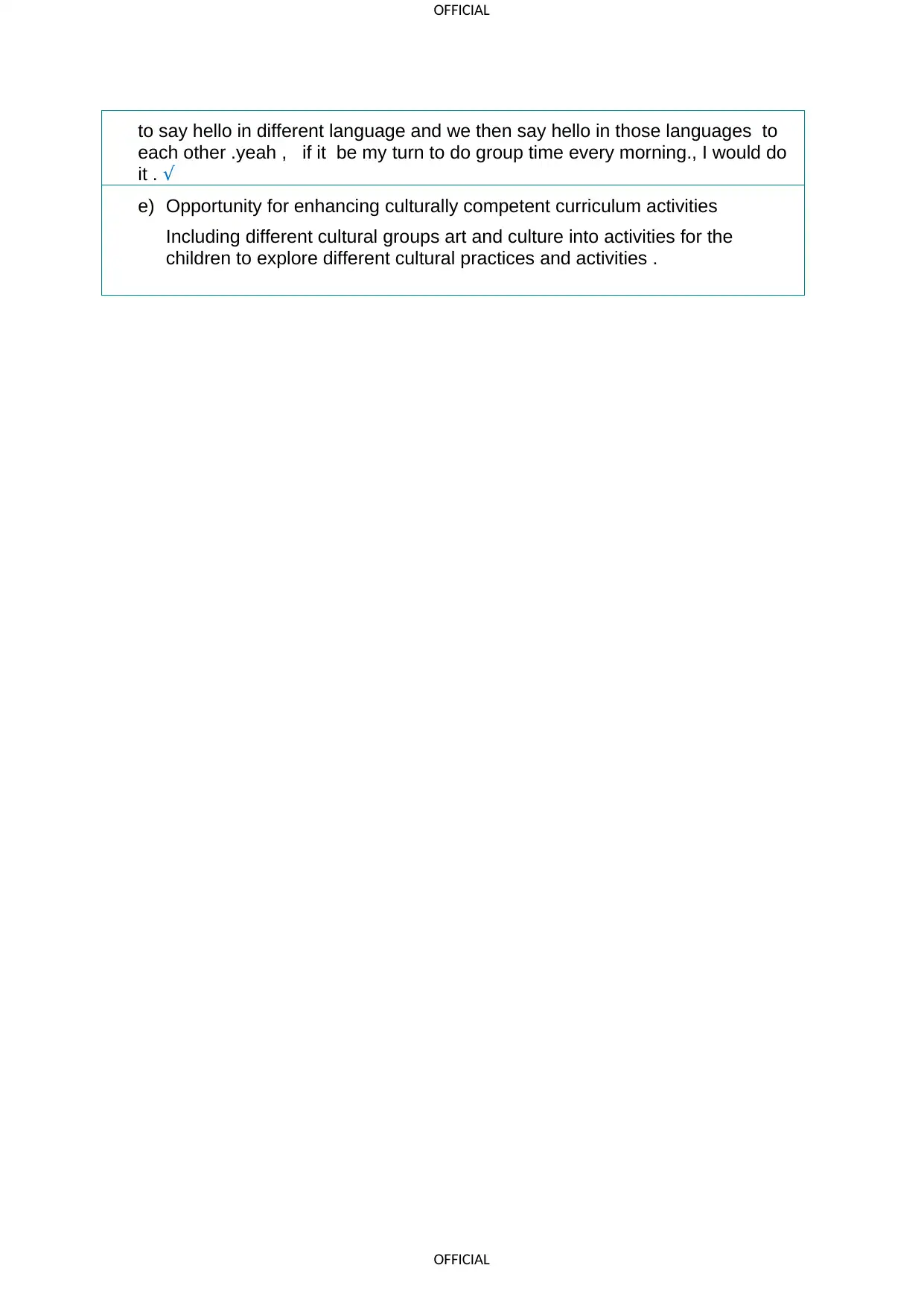
OFFICIAL
OFFICIAL
to say hello in different language and we then say hello in those languages to
each other .yeah , if it be my turn to do group time every morning., I would do
it . √
e) Opportunity for enhancing culturally competent curriculum activities
Including different cultural groups art and culture into activities for the
children to explore different cultural practices and activities .
OFFICIAL
to say hello in different language and we then say hello in those languages to
each other .yeah , if it be my turn to do group time every morning., I would do
it . √
e) Opportunity for enhancing culturally competent curriculum activities
Including different cultural groups art and culture into activities for the
children to explore different cultural practices and activities .
⊘ This is a preview!⊘
Do you want full access?
Subscribe today to unlock all pages.

Trusted by 1+ million students worldwide
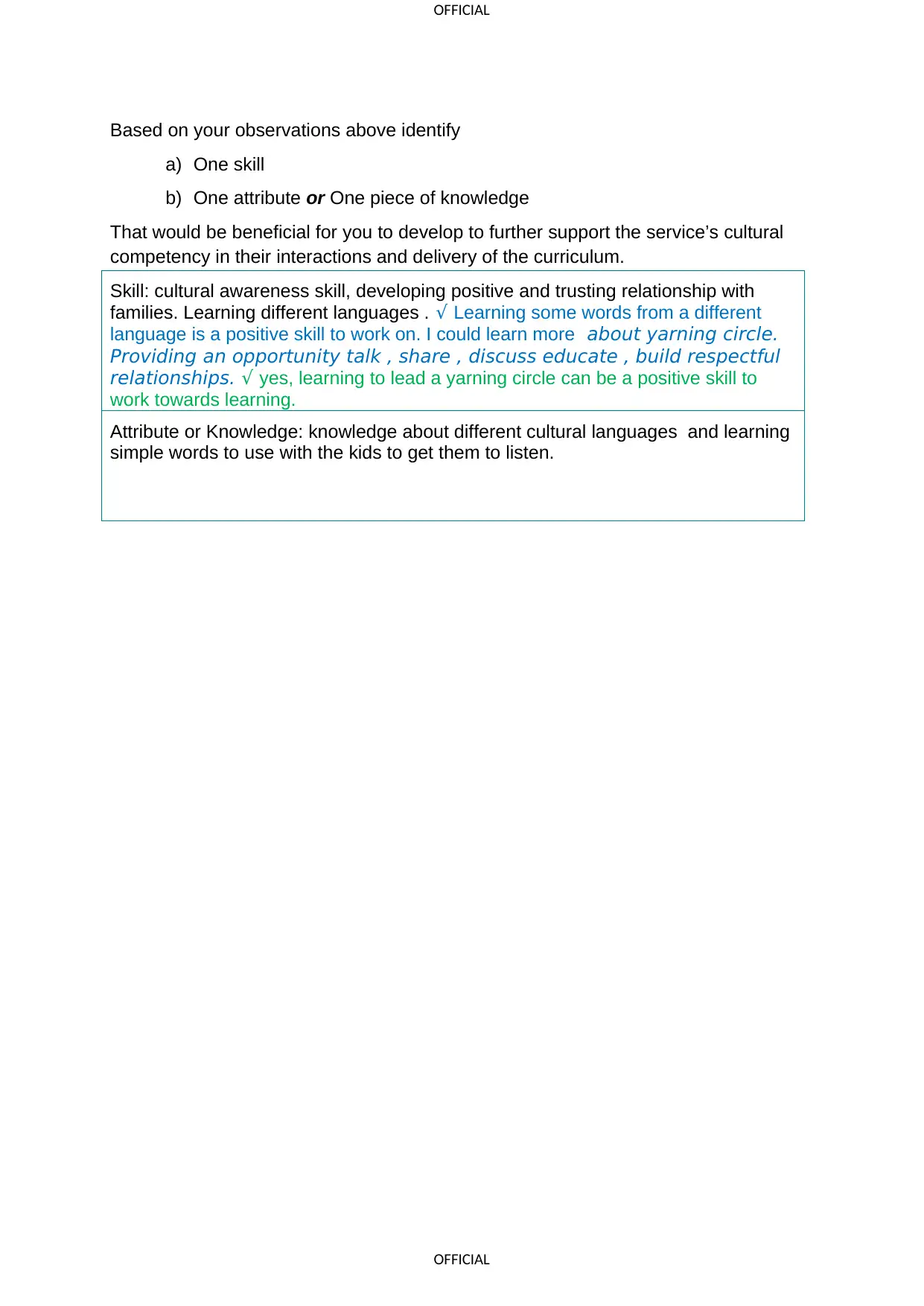
OFFICIAL
OFFICIAL
Based on your observations above identify
a) One skill
b) One attribute or One piece of knowledge
That would be beneficial for you to develop to further support the service’s cultural
competency in their interactions and delivery of the curriculum.
Skill: cultural awareness skill, developing positive and trusting relationship with
families. Learning different languages . √ Learning some words from a different
language is a positive skill to work on. I could learn more about yarning circle.
Providing an opportunity talk , share , discuss educate , build respectful
relationships. √ yes, learning to lead a yarning circle can be a positive skill to
work towards learning.
Attribute or Knowledge: knowledge about different cultural languages and learning
simple words to use with the kids to get them to listen.
OFFICIAL
Based on your observations above identify
a) One skill
b) One attribute or One piece of knowledge
That would be beneficial for you to develop to further support the service’s cultural
competency in their interactions and delivery of the curriculum.
Skill: cultural awareness skill, developing positive and trusting relationship with
families. Learning different languages . √ Learning some words from a different
language is a positive skill to work on. I could learn more about yarning circle.
Providing an opportunity talk , share , discuss educate , build respectful
relationships. √ yes, learning to lead a yarning circle can be a positive skill to
work towards learning.
Attribute or Knowledge: knowledge about different cultural languages and learning
simple words to use with the kids to get them to listen.
Paraphrase This Document
Need a fresh take? Get an instant paraphrase of this document with our AI Paraphraser
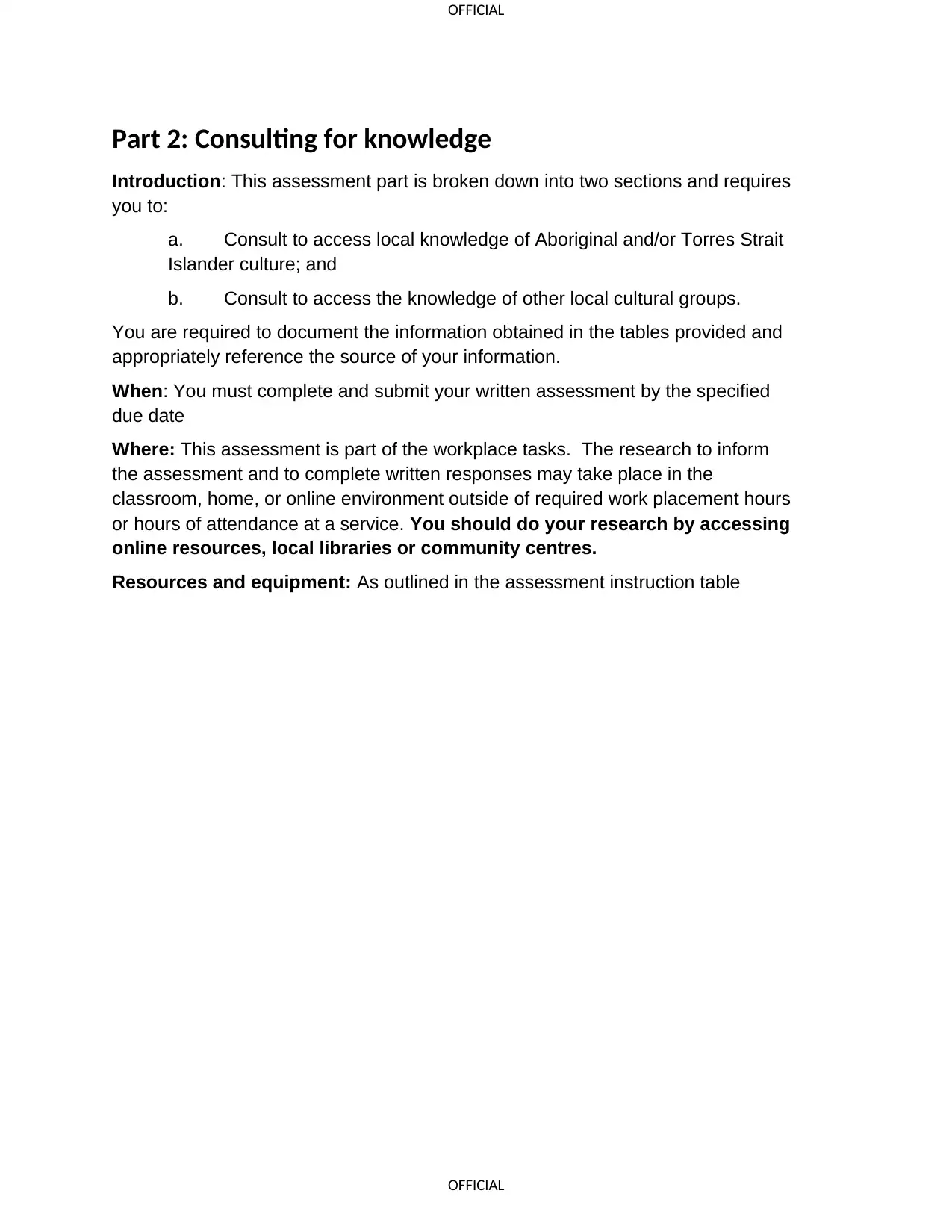
OFFICIAL
OFFICIAL
Part 2: Consulting for knowledge
Introduction: This assessment part is broken down into two sections and requires
you to:
a. Consult to access local knowledge of Aboriginal and/or Torres Strait
Islander culture; and
b. Consult to access the knowledge of other local cultural groups.
You are required to document the information obtained in the tables provided and
appropriately reference the source of your information.
When: You must complete and submit your written assessment by the specified
due date
Where: This assessment is part of the workplace tasks. The research to inform
the assessment and to complete written responses may take place in the
classroom, home, or online environment outside of required work placement hours
or hours of attendance at a service. You should do your research by accessing
online resources, local libraries or community centres.
Resources and equipment: As outlined in the assessment instruction table
OFFICIAL
Part 2: Consulting for knowledge
Introduction: This assessment part is broken down into two sections and requires
you to:
a. Consult to access local knowledge of Aboriginal and/or Torres Strait
Islander culture; and
b. Consult to access the knowledge of other local cultural groups.
You are required to document the information obtained in the tables provided and
appropriately reference the source of your information.
When: You must complete and submit your written assessment by the specified
due date
Where: This assessment is part of the workplace tasks. The research to inform
the assessment and to complete written responses may take place in the
classroom, home, or online environment outside of required work placement hours
or hours of attendance at a service. You should do your research by accessing
online resources, local libraries or community centres.
Resources and equipment: As outlined in the assessment instruction table
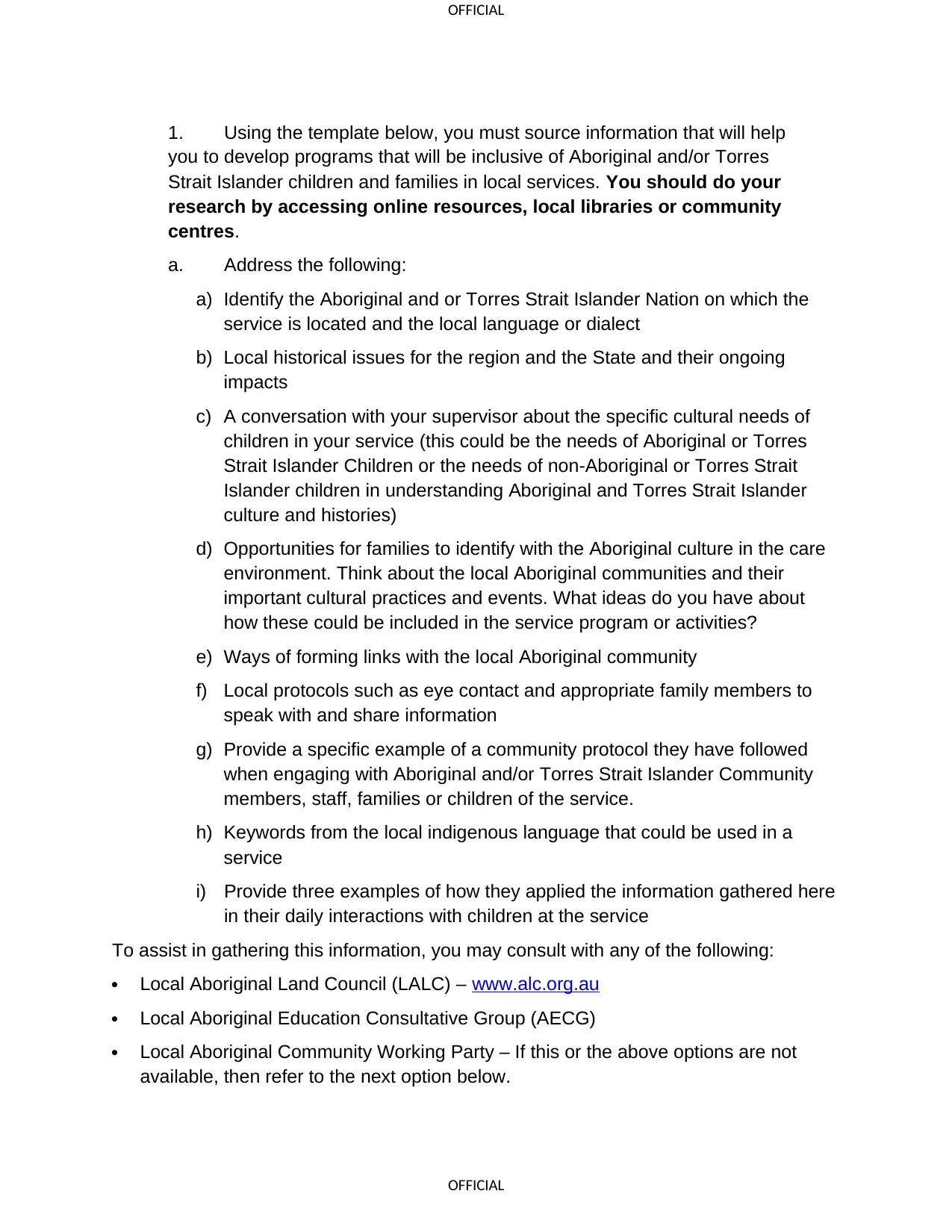
OFFICIAL
OFFICIAL
1. Using the template below, you must source information that will help
you to develop programs that will be inclusive of Aboriginal and/or Torres
Strait Islander children and families in local services. You should do your
research by accessing online resources, local libraries or community
centres.
a. Address the following:
a) Identify the Aboriginal and or Torres Strait Islander Nation on which the
service is located and the local language or dialect
b) Local historical issues for the region and the State and their ongoing
impacts
c) A conversation with your supervisor about the specific cultural needs of
children in your service (this could be the needs of Aboriginal or Torres
Strait Islander Children or the needs of non-Aboriginal or Torres Strait
Islander children in understanding Aboriginal and Torres Strait Islander
culture and histories)
d) Opportunities for families to identify with the Aboriginal culture in the care
environment. Think about the local Aboriginal communities and their
important cultural practices and events. What ideas do you have about
how these could be included in the service program or activities?
e) Ways of forming links with the local Aboriginal community
f) Local protocols such as eye contact and appropriate family members to
speak with and share information
g) Provide a specific example of a community protocol they have followed
when engaging with Aboriginal and/or Torres Strait Islander Community
members, staff, families or children of the service.
h) Keywords from the local indigenous language that could be used in a
service
i) Provide three examples of how they applied the information gathered here
in their daily interactions with children at the service
To assist in gathering this information, you may consult with any of the following:
Local Aboriginal Land Council (LALC) – www.alc.org.au
Local Aboriginal Education Consultative Group (AECG)
Local Aboriginal Community Working Party – If this or the above options are not
available, then refer to the next option below.
OFFICIAL
1. Using the template below, you must source information that will help
you to develop programs that will be inclusive of Aboriginal and/or Torres
Strait Islander children and families in local services. You should do your
research by accessing online resources, local libraries or community
centres.
a. Address the following:
a) Identify the Aboriginal and or Torres Strait Islander Nation on which the
service is located and the local language or dialect
b) Local historical issues for the region and the State and their ongoing
impacts
c) A conversation with your supervisor about the specific cultural needs of
children in your service (this could be the needs of Aboriginal or Torres
Strait Islander Children or the needs of non-Aboriginal or Torres Strait
Islander children in understanding Aboriginal and Torres Strait Islander
culture and histories)
d) Opportunities for families to identify with the Aboriginal culture in the care
environment. Think about the local Aboriginal communities and their
important cultural practices and events. What ideas do you have about
how these could be included in the service program or activities?
e) Ways of forming links with the local Aboriginal community
f) Local protocols such as eye contact and appropriate family members to
speak with and share information
g) Provide a specific example of a community protocol they have followed
when engaging with Aboriginal and/or Torres Strait Islander Community
members, staff, families or children of the service.
h) Keywords from the local indigenous language that could be used in a
service
i) Provide three examples of how they applied the information gathered here
in their daily interactions with children at the service
To assist in gathering this information, you may consult with any of the following:
Local Aboriginal Land Council (LALC) – www.alc.org.au
Local Aboriginal Education Consultative Group (AECG)
Local Aboriginal Community Working Party – If this or the above options are not
available, then refer to the next option below.
⊘ This is a preview!⊘
Do you want full access?
Subscribe today to unlock all pages.

Trusted by 1+ million students worldwide
1 out of 44
Related Documents
Your All-in-One AI-Powered Toolkit for Academic Success.
+13062052269
info@desklib.com
Available 24*7 on WhatsApp / Email
![[object Object]](/_next/static/media/star-bottom.7253800d.svg)
Unlock your academic potential
Copyright © 2020–2025 A2Z Services. All Rights Reserved. Developed and managed by ZUCOL.




